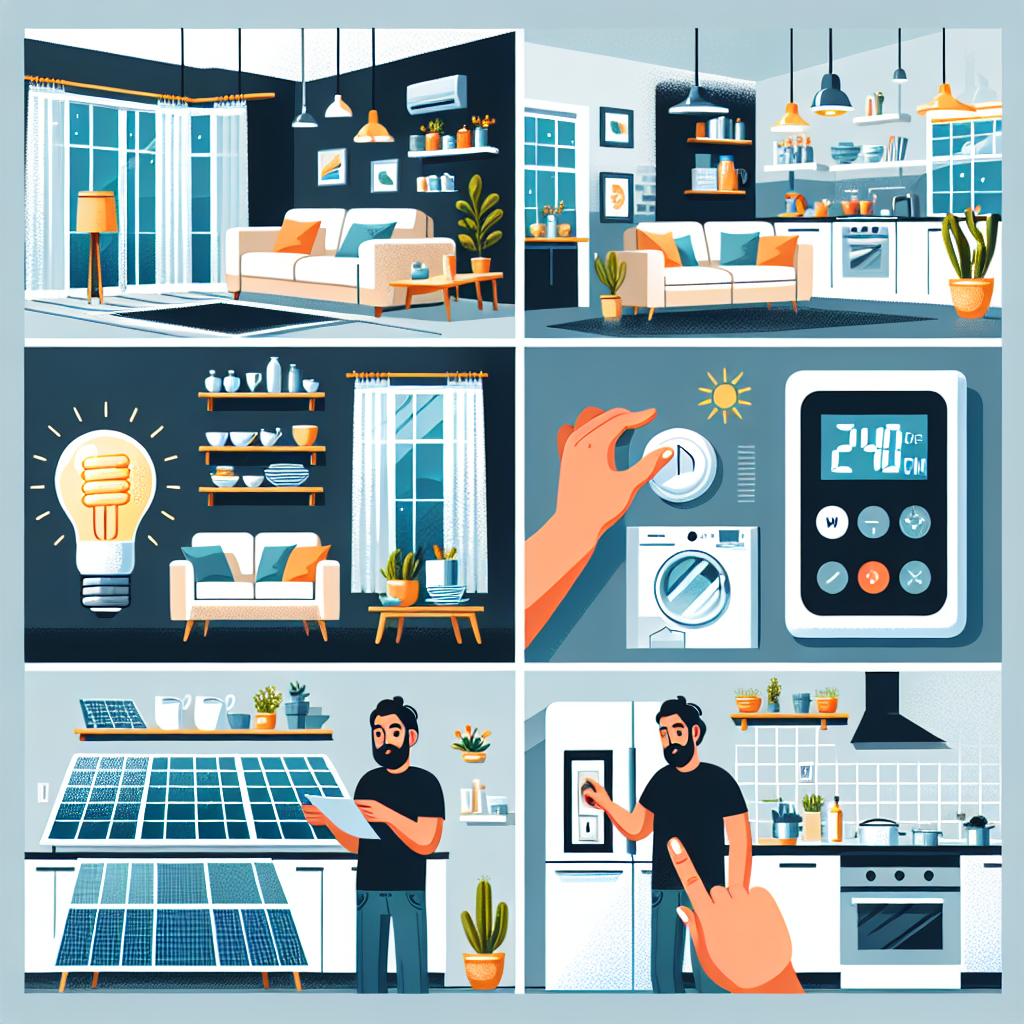-
Table of Contents
“Save money and the planet with these simple home energy hacks!”
Introduction
Home energy hacks are simple and effective ways to reduce energy consumption and save money on utility bills. These hacks involve making small changes to daily habits and routines, as well as implementing energy-efficient technologies and practices in the home. By incorporating these hacks into our lives, we can not only reduce our carbon footprint but also contribute to a more sustainable future. In this article, we will explore some of the most practical and easy-to-implement home energy hacks that can make a significant difference in our energy usage.
5 Simple Ways to Reduce Your Home’s Energy Consumption
In today’s world, where energy consumption is at an all-time high, it is important for us to take steps towards reducing our carbon footprint. One of the easiest ways to do so is by making small changes in our daily habits and routines. These changes not only help in reducing our impact on the environment but also save us money in the long run. In this article, we will discuss five simple ways to reduce your home’s energy consumption.
The first and most obvious step towards reducing energy consumption is by switching to energy-efficient appliances. This includes replacing old light bulbs with LED ones, using energy-efficient refrigerators and washing machines, and investing in a smart thermostat. These appliances may have a higher upfront cost, but they consume significantly less energy, resulting in lower electricity bills.
Another way to reduce energy consumption is by being mindful of our water usage. Simple habits like turning off the tap while brushing our teeth or fixing any leaks in the plumbing can save a significant amount of water and energy. Additionally, investing in low-flow showerheads and faucets can also help in reducing water and energy usage.
One of the biggest energy consumers in our homes is heating and cooling systems. To reduce their energy consumption, it is important to properly insulate our homes. This includes sealing any gaps or cracks in doors and windows, adding insulation to walls and attics, and using curtains or blinds to regulate the temperature inside the house. By doing so, we can reduce the amount of energy needed to heat or cool our homes, resulting in lower energy bills.
Another simple yet effective way to reduce energy consumption is by unplugging electronics when not in use. Many of us have a habit of leaving our chargers and appliances plugged in even when they are not being used. This results in a phenomenon called “vampire energy” where these devices continue to consume energy even when they are turned off. By unplugging them, we can save a significant amount of energy and reduce our electricity bills.
Lastly, we can also reduce our home’s energy consumption by making small changes in our daily habits. For example, instead of using the dryer, we can hang our clothes to dry, which not only saves energy but also helps in preserving the quality of our clothes. Similarly, we can opt for natural light during the day instead of turning on lights, and use a microwave instead of an oven for small cooking tasks. These small changes may seem insignificant, but they can add up to significant energy savings over time.
In addition to these five simple ways, there are many other home energy hacks that we can incorporate into our daily lives. For example, using a power strip to plug in multiple devices and turning it off when not in use can help in reducing vampire energy. Similarly, using a dishwasher instead of hand-washing dishes can save both water and energy. It is also important to regularly maintain our appliances and HVAC systems to ensure they are running efficiently.
In conclusion, reducing our home’s energy consumption is not only beneficial for the environment but also for our wallets. By making small changes in our daily habits and investing in energy-efficient appliances, we can significantly reduce our carbon footprint and save money on our energy bills. It is important for us to be mindful of our energy usage and take steps towards a more sustainable future.
The Top Energy-Saving Appliances for Your Home
In today’s world, where energy conservation and sustainability are becoming increasingly important, it is essential to make conscious choices about the appliances we use in our homes. Not only do energy-efficient appliances help reduce our carbon footprint, but they also save us money in the long run. With the advancement of technology, there are now a plethora of energy-saving appliances available in the market. In this article, we will discuss the top energy-saving appliances for your home.
First on the list is the refrigerator. It is one of the most energy-consuming appliances in any household. However, with the introduction of energy-efficient models, this is no longer the case. Energy Star certified refrigerators use 15% less energy than non-certified models. They achieve this by using advanced insulation and compressors, which help keep the temperature consistent while using less energy. Additionally, these refrigerators also come with features such as automatic defrost and adaptive defrost, which further reduce energy consumption.
Next up is the washing machine. Traditional top-loading washing machines use a significant amount of water and energy. However, front-loading washing machines are designed to use less water and energy while still providing the same level of cleaning. They also have a higher spin speed, which means clothes come out drier, reducing the time and energy needed for drying. Energy Star certified washing machines use 25% less energy and 33% less water than non-certified models, making them a great choice for energy-conscious households.
Another energy-saving appliance that often goes unnoticed is the dishwasher. Energy Star certified dishwashers use advanced technology to clean dishes more efficiently while using less water and energy. They also have features such as soil sensors, which adjust the wash cycle based on the level of dirt on the dishes, further reducing energy consumption. Additionally, using a dishwasher instead of hand-washing dishes can save up to 5,000 gallons of water per year.
Moving on to the kitchen, we have the stove and oven. Traditional electric stoves and ovens use a significant amount of energy, but there are now energy-efficient options available. Induction cooktops use electromagnetic energy to heat the cookware directly, making them more efficient than traditional electric or gas stoves. They also heat up faster and cool down quicker, reducing cooking time and energy consumption. Additionally, convection ovens use a fan to circulate hot air, cooking food faster and more evenly, thus reducing energy usage.
Next, we have the water heater. Traditional water heaters continuously heat and store water, even when not in use, resulting in energy wastage. Tankless water heaters, on the other hand, only heat water when needed, making them more energy-efficient. They also have a longer lifespan and take up less space, making them a great choice for smaller homes.
Last but not least, we have the air conditioner. With summers getting hotter each year, air conditioners have become a necessity in many households. However, they also consume a significant amount of energy. Energy Star certified air conditioners use 8% less energy than non-certified models. They achieve this by using advanced technology, such as variable-speed compressors, which adjust the cooling based on the temperature outside, thus reducing energy consumption.
In conclusion, making the switch to energy-saving appliances not only benefits the environment but also saves us money in the long run. When purchasing new appliances, look for the Energy Star label, which indicates that the appliance meets strict energy efficiency guidelines. Additionally, regular maintenance and proper usage of appliances can also help reduce energy consumption. By making small changes in our daily lives, we can make a significant impact on the environment and our wallets.
Maximizing Natural Light: Tips for a Brighter and More Energy-Efficient Home
In today’s world, where energy conservation and sustainability are becoming increasingly important, finding ways to make our homes more energy-efficient is crucial. Not only does it help reduce our carbon footprint, but it also helps save money on utility bills. One simple yet effective way to achieve this is by maximizing natural light in our homes. Not only does natural light make our homes look brighter and more inviting, but it also has numerous benefits for our health and well-being. In this article, we will discuss some tips and tricks for maximizing natural light in our homes, making them brighter and more energy-efficient.
The first step towards maximizing natural light in our homes is to understand the layout and orientation of our house. The direction in which our house faces plays a significant role in the amount of natural light it receives. South-facing homes tend to receive the most sunlight throughout the day, while north-facing homes receive the least. East-facing homes receive the most sunlight in the morning, while west-facing homes receive the most in the afternoon. By understanding the orientation of our house, we can plan our interior design and furniture placement accordingly to make the most of natural light.
Another important factor to consider is the type of windows we have in our homes. Windows not only provide a view to the outside world but also allow natural light to enter our homes. Choosing the right type of windows can make a significant difference in the amount of natural light that enters our homes. Large, unobstructed windows are ideal for maximizing natural light, as they allow more sunlight to enter. Additionally, installing skylights or light tubes can also be a great way to bring in more natural light, especially in rooms with limited or no windows.
Apart from the layout and windows, the color scheme of our homes also plays a crucial role in maximizing natural light. Lighter colors tend to reflect more light, making a room appear brighter and more spacious. Painting walls and ceilings in light colors such as white, cream, or pastel shades can help reflect natural light and make a room feel more open and airy. Additionally, using light-colored furniture and decor can also contribute to a brighter and more energy-efficient home.
Another simple yet effective way to maximize natural light is by keeping our windows clean. Over time, windows can accumulate dirt, dust, and grime, which can block natural light from entering our homes. Regularly cleaning our windows can help ensure that we are making the most of natural light. Additionally, keeping our windows unobstructed by furniture or curtains can also help maximize natural light.
In addition to making our homes brighter and more inviting, natural light also has numerous health benefits. Exposure to natural light has been linked to improved mood, increased productivity, and better sleep. By maximizing natural light in our homes, we can create a healthier and more comfortable living environment for ourselves and our families.
In conclusion, maximizing natural light in our homes is not only beneficial for the environment and our wallets but also for our health and well-being. By understanding the layout and orientation of our homes, choosing the right type of windows, using light colors, and keeping our windows clean and unobstructed, we can make our homes brighter and more energy-efficient. So let’s make the most of natural light and create a brighter, healthier, and more sustainable living space for ourselves and future generations.
Q&A
1) What are some simple home energy hacks that can help save money on utility bills?
Some simple home energy hacks include turning off lights and electronics when not in use, using energy-efficient light bulbs, sealing air leaks around windows and doors, and adjusting the thermostat to a slightly lower temperature in the winter and higher temperature in the summer.
2) How can using smart home technology help with energy efficiency?
Smart home technology, such as smart thermostats and energy monitoring systems, can help with energy efficiency by allowing homeowners to control and monitor their energy usage in real-time. This can help identify areas where energy is being wasted and make adjustments to save money on utility bills.
3) Are there any DIY projects that can improve a home’s energy efficiency?
Yes, there are several DIY projects that can improve a home’s energy efficiency. These include adding insulation to walls and attics, installing weather stripping around doors and windows, and using caulk to seal any air leaks. Additionally, installing low-flow showerheads and faucet aerators can also help conserve water and save on energy costs.
Conclusion
In conclusion, implementing home energy hacks can greatly benefit both the environment and our wallets. By making small changes such as using energy-efficient appliances, adjusting thermostat settings, and utilizing natural light, we can reduce our energy consumption and save money on utility bills. Additionally, incorporating renewable energy sources like solar panels can further decrease our reliance on non-renewable resources. These simple hacks not only have a positive impact on our personal finances, but also contribute to a more sustainable future for our planet. It is important for individuals to take responsibility and make conscious efforts to reduce their energy usage in order to create a more energy-efficient and eco-friendly home.







